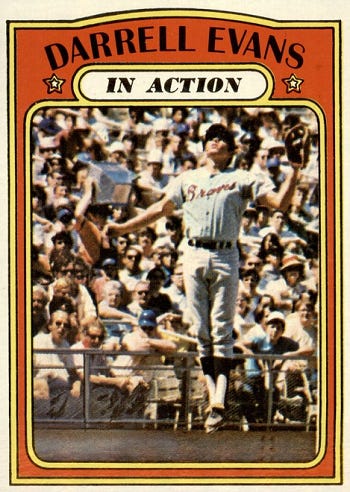If you’re a fan of big swings and jumps in performance and all-or-nothing sorts of production, take a look at the inimitable resume Darrell Evans put up during his 21-year major league career sometime.
There you’ll find a guy who leapt from 19 home runs in 1972 to 41 in 1973 … a guy who swung from 16 to 40 dingers between 1984 and 1985 … a guy who got on base at SABR Hero levels … a guy who struck out a bunch and hit for low averages but still delivered the run-producing goods out the wazoo.
You can find traces of those swings and leaps forward in his draft positions, too …
- 13th round of the June 1965 Draft (Cubs)
- 2nd round of the January 1966 Draft (Yankees)
- 5th round of the June 1966 Draft (Tigers)
- 3rd round of the January 1967 Draft (Phillies)
- 7th round of the June 1967 Draft (Athletics)
After signing with the A’s, Evans (finally) began his minor league career before another draft got him — this time, though, it was the Rule 5 variety in December of 1968 that landed him with the Atlanta Braves.
That pick led to a modest 12-game showing with the Braves in 1969 and then Evans’ first baseball card in the 1970 Topps set, right there between Mike McQueen and Rick Kester as an Atlanta “Rookie Star.”
Check prices on eBay (affiliate link)
Check prices on Amazon (affiliate link)
But it didn’t quite work out that way, because — as he was wont to do — Evans leaned into another big swing cycle.
For starters, Evans began 1970 at Triple-A Richmond and stayed there through the minor league season despite batting .300 and connecting on 20 home runs. He did get another call to Atlanta in September but showed almost no power despite hitting .318 in 12 games.
That left him heading into his age-24 season without a clear shot at regular playing time in the big leagues and, with less than 100 career plate appearances under his belt, it also left Evans without a sophomore card in the black-bordered 1971 Topps set.
After a hot start back in Richmond in 1971, though, Evans returned to Atlanta before the end of May, and he was there to stay. In 89 games through the end of the season, Evans mustered just a .242 batting average, but he did manage to smack 12 home runs and drive in 38 runs.
By the end of the season, Howdy Doody was the Braves’ regular third baseman, and things were looking up.
Topps thought so, too, because, not only did the Old Gum Company bring Evans back for a regular 1972 card (#171), they also added him to their roster of “In Action” cards on #172:
Check prices on eBay (affiliate link)
Check prices on Amazon (affiliate link)
Now, that didn’t exactly put him in exclusive company, seeing as how there were about six dozen players and managers thusly featured. But has there ever been a more dramatic jump in cardboard fortunes — dropped from the roster one year, favored son the next?
(Not to mention Evans’ jump *on* the card.)
Maybe. Probably.
But the fact is, Darrell Evans pulled it off.
Which makes you wonder, all these years later, if there isn’t another big swing left in Evans’ arsenal. Because, even though he fell off the Hall of Fame ballot after one try in 1995, his Cooperstown resume stands right there with other guys from his era who have either made the cut or whom many fans want to make the cut.
So, could we see Darrell Evans on the induction dais someday?
Still seems like a longshot, but then, you gotta figure that 1972 Topps In Action card of his wasn’t even a pipe dream as the 1971 season dawned … don’t you think?
Want to see a video version of this article?

1972 Topps Basketball #228 Bob Netolicky STARX 5 EX (LS806115)
 | $1.99 End Date: Friday 05/17/2024 16:43:04 EDT Buy it now | Add to watch list |
1972 Topps - #622 Most Valuable Player Award card- EX
 | $5.00 End Date: Friday 05/17/2024 15:08:17 EDT Buy it now | Add to watch list |
1972 Topps Basketball #259 Scott/Barry/Issel LL STARX 5 EX (LS806102)
 | $3.99 End Date: Friday 05/17/2024 16:42:01 EDT Buy it now | Add to watch list |
1972 Topps - #229 1971 World Series Game No. 7 card- EX
 | $2.50 End Date: Friday 05/17/2024 16:05:28 EDT Buy it now | Add to watch list |
1972 Topps CARL YASTRZEMSKI Card No. 38 In Action Crease-Free NM
 | $14.95 End Date: Friday 05/17/2024 18:21:49 EDT Buy it now | Add to watch list |
1972 Topps - #105 Gary Gentry
 | $0.67 End Date: Wednesday 04/24/2024 16:24:15 EDT Bid now | Add to watch list |
1972 Topps Football Card #235 George Blanda Oakland Raiders
 | $2.00 End Date: Friday 05/17/2024 17:24:07 EDT Buy it now | Add to watch list |
1972 Topps - #225 1971 World Series Game No. 3 card- EX
 | $2.50 End Date: Friday 05/17/2024 15:54:05 EDT Buy it now | Add to watch list |
1972 Topps Basketball #092 Don Nelson STARX 5 EX (LS806085)
 | $2.99 End Date: Friday 05/17/2024 16:41:12 EDT Buy it now | Add to watch list |
1972 Topps Pick a Card Complete your Set VG-NM-MT 367-787 UPDATED W/HI NUMBERS
 | $0.99 End Date: Monday 05/06/2024 14:15:03 EDT Buy it now | Add to watch list |








Recent Comments